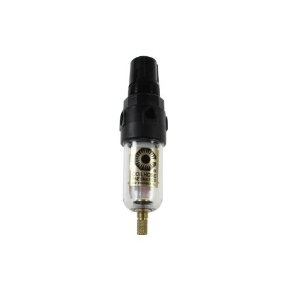How To Build A Water Trap For Air Compressor
Hey! This site is reader-supported and nosotros earn commissions if you purchase products from retailers after clicking on a link from our site.
Accept you got h2o in the compressed air lines, or dripping out of the air tool exhaust port?
H2o vapor is a by-product of compressing air.
Non to say that the compressor makes water, information technology's just that the more air you cram into a small space like the compressor tank, the greater the concentration of water vapor in that decreased size, and complimentary water tends to condense out of that high-vapor-content compressed air into the tank.
Yes, that's why you lot should drain the compressor tank later every use. Forgetting to do and then will, besides create a rust risk in the tank, allow water to build up in the tank and then blow out the discharge line, through the regulator, and down the air line to your air tools.

Water in the compressed air lines – what tin yous do?
Well, likewise draining the tank after every use, and installing a device similar you run across above (more on that in a bit), a meliorate understanding of what is happening in the air line from the tank to your air tool volition help, as will understanding the impact of the local humidity on the corporeality of h2o building up in your compressor tank.
If you are using your air compressor on a hot and humid mean solar day, your compressor will accept more than water in the tank than if yous were using the same compressor on a cool, non-humid day. Humid air has lots more water in it than cool, dry air, and driving that hot and humid air into the compressor tank ensures that more h2o vapor will condense out in the tank as free water. You take chances that water beingness diddled down the line to your tool.
And so, as the air from the compressor tank moves downward the air line to your air tools, the compressed air cools. As that air cools, information technology allows water to catechumen from vapor to free water in the air line. Equally a result, you might find water dripping out of the air tool.
Or, if you lot are spray painting, your piece of work piece will end up with a lot of fish optics due to the h2o spraying out with the paint.
Filter and regulator
A smaller, home workshop air compressor probable came equipped with an air regulator.
It should too have come equipped with a compressed air filter, besides known every bit a h2o trap. It didn't we doubtable because in their bulldoze to bring you the cheapest air compressors on the marketplace, adding a compressed air filter would increase the price.
The photo of the device earlier is that of a combination filter / regulator. The air from the tank enters the filter part of the device first, removing any debris and costless water from the air stream, and then blows on through the regulator, and then down to the air line. Whatsoever free water coming from the tank will be taken out of the air stream by the filter at the tank.
You might besides decide to add an in-line filter upstream from the regulator since your compressor already has the regulator.
Another filter?
That will not bargain with h2o than condenses in the air hose, however.
Retrieve about it. An air hose full of warm, moist air is likely sitting on the cold floor of the garage or basement. That will rapidly absurd the air in the hose, and lots of water will condense out in the hose.
If y'all are experiencing that, mount another filter on the wall nigh the work bench, plumb the air line from the compressor into that filter, and add a short air line from the filter to the workbench then you have air for your air tools that has had even more than h2o removed from it.
That will take care of about of the h2o problems.
Still h2o dripping out of the air tool?
If you still have water dripping from the air tool, it's likely that in that location is enough warm, moisture compressed air getting to the tool, and since moving air cools, operating the air tool is – in event – cooling the compressed air, and you are yet getting water vapor condensing in, and dripping out of, the air tool.
That being the case, yous'll need to add together an in-line desiccant air dryer just before the air tool. That will strip all remaining water and water vapor from the compressed air stream, and should resolve the dripping water syndrome.
Comments or questions? Use the form below.
How To Build A Water Trap For Air Compressor,
Source: https://fix-my-compressor.com/water-in-the-compressed-air-lines/
Posted by: joneslessed.blogspot.com


0 Response to "How To Build A Water Trap For Air Compressor"
Post a Comment